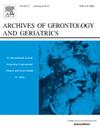Cost-effectiveness analysis of tube feeding among older adults with advanced dementia in Japan: A net benefit regression approach
IF 3.5
3区 医学
Q2 GERIATRICS & GERONTOLOGY
引用次数: 0
Abstract
Background
This study aims to assess the cost-effectiveness of percutaneous endoscopic gastrostomy (PEG) and nasogastric tube (NGT) in older adults with advanced dementia, compared with non-artificial nutrition.
Methods
Retrospective cohort study. Medical claims data and long-term care claims data from Fukuoka Prefecture, Japan, were used. We identified 3,882 older adults (≥75 years) with advanced dementia who were hospitalized between April 2016 and March 2019 due to dysphagia, malnutrition, or aspiration pneumonia. Using propensity score matching, we matched 192 patients in the PEG group with 192 in the non-artificial nutrition group, and 490 patients in the NGT group with 490 in the non-artificial nutrition group. We examined the survival years and total costs of each patient from the date of admission to March 31, 2020, and thereby estimated the cost-effectiveness of PEG and NGT, respectively, versus non-artificial nutrition. The net benefit regression model was employed to estimate the incremental net benefits (INB) with varying values of willingness-to-pay (WTP) for PEG and NGT. Furthermore, cost-effectiveness acceptability curve was used to present the probability of the cost-effectiveness of each intervention.
Results
As WTP increased from JPY 7,747,909 (equivalent to US$51,546) to JPY 28,163,651 (equivalent to US$187,371), the probability of PEG being cost-effective increased from 50 % to nearly100 %. The NGT group had negative INB estimates.
Conclusions
Both PEG and NGT are less likely to provide economic values for patients with advanced dementia. However, this conclusion should be further refined through detailed cost-effectiveness analysis from multiple perspectives.
求助全文
约1分钟内获得全文
求助全文
来源期刊
CiteScore
7.30
自引率
5.00%
发文量
198
审稿时长
16 days
期刊介绍:
Archives of Gerontology and Geriatrics provides a medium for the publication of papers from the fields of experimental gerontology and clinical and social geriatrics. The principal aim of the journal is to facilitate the exchange of information between specialists in these three fields of gerontological research. Experimental papers dealing with the basic mechanisms of aging at molecular, cellular, tissue or organ levels will be published.
Clinical papers will be accepted if they provide sufficiently new information or are of fundamental importance for the knowledge of human aging. Purely descriptive clinical papers will be accepted only if the results permit further interpretation. Papers dealing with anti-aging pharmacological preparations in humans are welcome. Papers on the social aspects of geriatrics will be accepted if they are of general interest regarding the epidemiology of aging and the efficiency and working methods of the social organizations for the health care of the elderly.

 求助内容:
求助内容: 应助结果提醒方式:
应助结果提醒方式:


